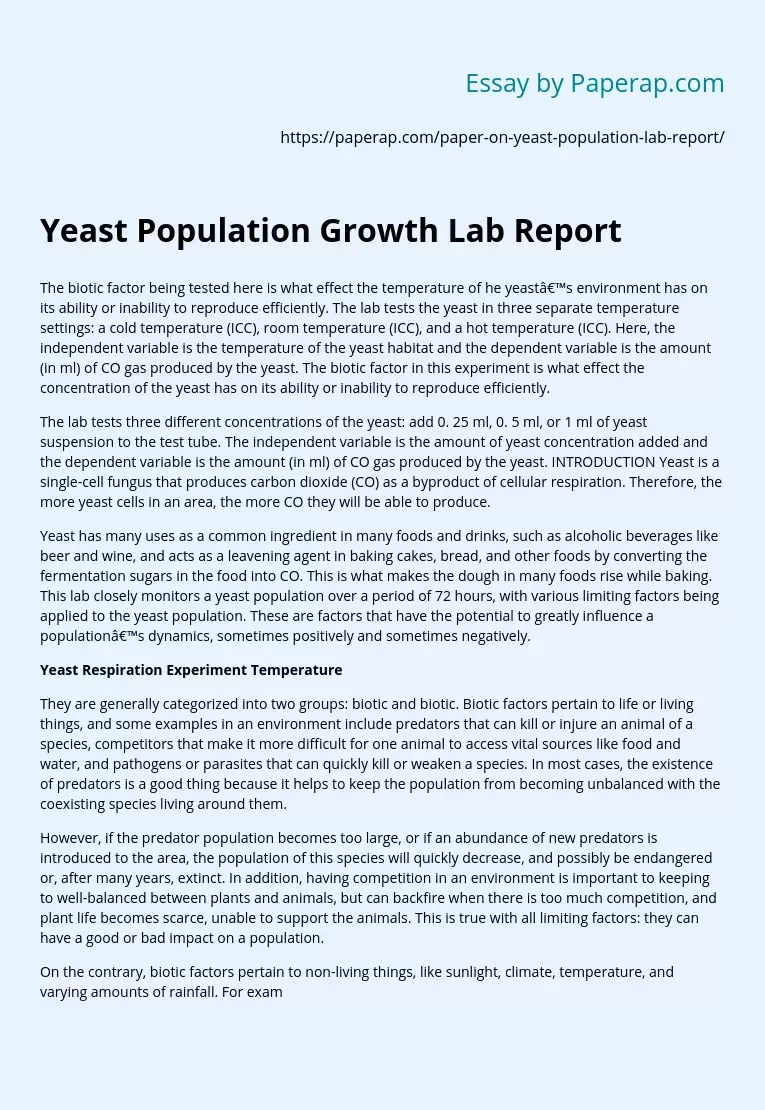Yeast Population Growth Lab Report
The biotic factor being tested here is what effect the temperature of he yeast’s environment has on its ability or inability to reproduce efficiently.
The lab tests the yeast in three separate temperature settings: a cold temperature (ICC), room temperature (ICC), and a hot temperature (ICC). Here, the independent variable is the temperature of the yeast habitat and the dependent variable is the amount (in ml) of CO gas produced by the yeast. The biotic factor in this experiment is what effect the concentration of the yeast has on its ability or inability to reproduce efficiently.
The lab tests three different concentrations of the yeast: add 0. 25 ml, 0. 5 ml, or 1 ml of yeast suspension to the test tube. The independent variable is the amount of yeast concentration added and the dependent variable is the amount (in ml) of CO gas produced by the yeast. INTRODUCTION Yeast is a single-cell fungus that produces carbon dioxide (CO) as a byproduct of cellular respiration.
Therefore, the more yeast cells in an area, the more CO they will be able to produce.
Yeast has many uses as a common ingredient in many foods and drinks, such as alcoholic beverages like beer and wine, and acts as a leavening agent in baking cakes, bread, and other foods by converting the fermentation sugars in the food into CO. This is what makes the dough in many foods rise while baking. This lab closely monitors a yeast population over a period of 72 hours, with various limiting factors being applied to the yeast population.
These are factors that have the potential to greatly influence a population’s dynamics, sometimes positively and sometimes negatively.
Yeast Respiration Experiment Temperature
They are generally categorized into two groups: biotic and biotic. Biotic factors pertain to life or living things, and some examples in an environment include predators that can kill or injure an animal of a species, competitors that make it more difficult for one animal to access vital sources like food and water, and pathogens or parasites that can quickly kill or weaken a species. In most cases, the existence of predators is a good thing because it helps to keep the population from becoming unbalanced with the coexisting species living around them.
However, if the predator population becomes too large, or if an abundance of new predators is introduced to the area, the population of this species will quickly decrease, and possibly be endangered or, after many years, extinct. In addition, having competition in an environment is important to keeping to well-balanced between plants and animals, but can backfire when there is too much competition, and plant life becomes scarce, unable to support the animals. This is true with all limiting factors: they can have a good or bad impact on a population.
On the contrary, biotic factors pertain to non-living things, like sunlight, climate, temperature, and varying amounts of rainfall. For example, rainfall is essential in an ecosystem to hydrate both animal and plant life, and it is necessary for survival. However, too much rainfall at one period of time, or flooding, can wash away and kill many forms of plant life, damaging the populations that rely on plants for food, in turn. In addition, temperature can impact a population like yeast (which is tested in this experiment) positively or negatively.
For example, if the yeast’s environment is very warm, the yeast will be able to thrive in it. This is due to its activation in warmer temperatures. It is able to reproduce faster and more efficiently in a warm environment, thus producing more CO. However, when placed in colder temperatures, it deactivates and, although it does not die or stop producing CO, this drastically slows down the rate of reproduction and production of CO. Therefore, these factors (both biotic and biotic) can potentially, given the circumstances, greatly impact the dynamics of a population.
This lab’s goal is to demonstrate these effects on yeast populations. Yeast is the most efficient model to demonstrate these population dynamics because it can easily be closely watched and it is a simple organism. Testing multicultural organisms in a lab can be more challenging because many of them possess some sort of rational thinking method that can impact the results in a lab. Yeast is a simple, unicellular organism that has only two intentions in its life: arrive and reproduce. This eliminates any impact that yeast’s intelligence could have on the experiment. This is one less control that needs to be worried about.
Also, yeast’s reproduction is rapid. If the lab were to test a multicultural organism, it would take weeks or even months to get a proper result. Using yeast, the lab only took 72 hours. Furthermore, collecting CO from the yeast is a viable method for determining the population growth of yeast because CO is a byproduct of the yeast’s cellular respiration process. As more yeast cells are produced, more CO will be produced because there will be more cells to reduce the gas in the enclosed environment as they respire, as measured through the volume displacement method.
A carrying capacity in a population is “the maximum number of individuals of a given species that an area’s resources can sustain indefinitely without significantly depleting or degrading those resources” (“Population Size”). Once the carrying capacity is reached or exceeded, this will take a toll on the environment as a whole. The resources that support this species would quickly diminish, and any other animals that this species preys on would become endangered because there are too many predators killing them.
Yeast Population Growth Lab Report. (2019, Dec 05). Retrieved from https://paperap.com/paper-on-yeast-population-lab-report/

